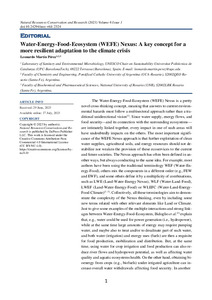Por favor, use este identificador para citar o enlazar este ítem:
https://repositorio.uca.edu.ar/handle/123456789/17244| Título: | Water-Energy-Food-Ecosystem (WEFE) Nexus : a key concept for a more resilient adaptation to the climate crisis | Autor: | Pérez, Leonardo Martín | Palabras clave: | AGUA; ENERGIA; ALIMENTOS; ECOSISTEMA; MEDIO AMBIENTE; PROTECCION AMBIENTAL; TIERRAS AGRICOLAS; CLIMA | Fecha de publicación: | 2023 | Editorial: | EnPress Publisher LLC | Cita: | Pérez, L. M. Water-Energy-Food-Ecosystem (WEFE) Nexus : a key concept for a more resilient adaptation to the climate crisis [en línea]. Natural Resources Conservation and Research. 2023, 6 (1). doi: 10.24294/nrcr.v6i1.2324. Disponible en: https://repositorio.uca.edu.ar/handle/123456789/17244 | Resumen: | Resumen: The Water-Energy-Food-Ecosystem (WEFE) Nexus is a pretty novel cross-thinking concept, meaning that answers to current environ-mental hazards must follow a multisectoral approach rather than a tra-ditional unidirectional vision[1]. Since water supply, energy flows, and food security—and its connection with the surrounding ecosystems—are intimately linked together, every impact in one of such areas will have undoubtedly impacts on the others. The most important signifi-cance of the WEFE Nexus approach is that further exploitation of clean water supplies, agricultural soils, and energy resources should not de-stabilize nor weaken the provision of these ecoservices to the current and future societies. The Nexus approach has often been defined in an-other ways, but always conducting to the same idea. For example, most authors have been using the traditional terminology WEF (Water-En-ergy-Food), others mix the components in a different order (e.g., FEW and EWF), and some others define it by a multiplicity of combinations, such as LWE (Land-Water-Energy Nexus), WLF (Water-Land-Food), LWEF (Land-Water-Energy-Food) or WLEFC (Water-Land-Energy-Food-Climate)[1–3]. Collectively, all these terminologies aim to demon-strate the complexity of the Nexus thinking, even by including some new terms related with other relevant elements like Land or Climate. Just to give some examples of the multiple interactions and strong link-ages between Water-Energy-Food-Ecosystem, Bidoglio et al.[2] explain that, e.g., water could be used for power generation (i.e., hydropower), while at the same time large amounts of energy may require pumping water, and maybe also to treat and/or to desalinate part of such water, and both water (irrigation) and energy uses (fuels) are then a requisite for food production, mobilization and distribution. But, at the same time, using water for crop irrigation and food production can also re-duce river flows and hydropower potential, as well as affecting water quality and aquatic ecosystems health. | URI: | https://repositorio.uca.edu.ar/handle/123456789/17244 | ISSN: | 2578-1936 | Disciplina: | INGENIERIA AMBIENTAL | DOI: | 10.24294/nrcr.v6i1.2324 | Derechos: | Acceso abierto | Fuente: | Natural Resources Conservation and Research. 2023, 6 (1) |
| Aparece en las colecciones: | Artículos Artículos |
Ficheros en este ítem:
| Fichero | Descripción | Tamaño | Formato | |
|---|---|---|---|---|
| water-energy-food-ecosystem.pdf | 116,61 kB | Adobe PDF |  Visualizar/Abrir |
Visualizaciones de página(s)
54
comprobado en 27-abr-2024
Descarga(s)
25
comprobado en 27-abr-2024
Google ScholarTM
Ver en Google Scholar
Altmetric
Altmetric
Este ítem está sujeto a una Licencia Creative Commons

